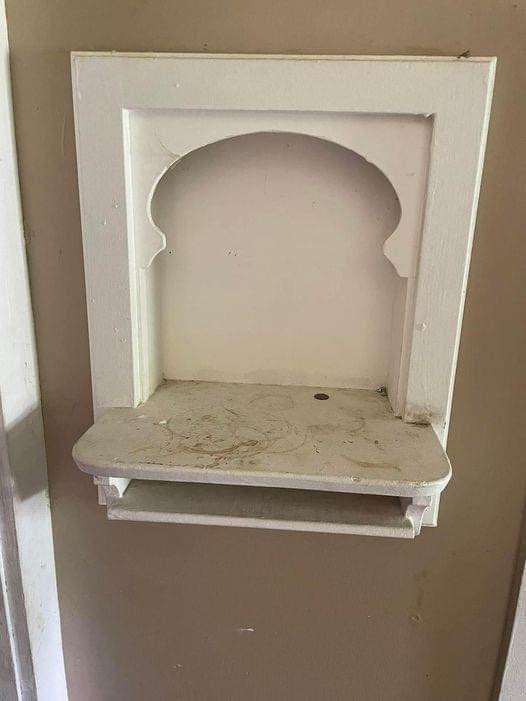If you live in a home built between the early to mid-1900s, you may have noticed a small, built-in shelf tucked into the wall, often in the kitchen or hallway. It might seem like an odd architectural feature today, but back in the day, it served a very practical purpose. So, what was this tiny shelf for, and why was it so common in older homes? Let’s explore its origins and why it was designed this way.

The Mystery of the Tiny Wall Shelf
This small wall shelf is known as a “phone alcove.” Long before the era of smartphones, homes were built to accommodate a central landline phone—usually the only phone in the house. Landlines were the primary way people communicated, making phone alcoves a necessary part of home design.
These phone alcoves were generally located in high-traffic areas like the kitchen or hallway, making them accessible for everyone in the house. The small shelf was typically positioned at a convenient height, allowing the phone to rest on it. Beneath the phone alcove, there was often a tiny drawer or compartment intended to hold an address book, phone directory, or a notepad for jotting down messages. This setup was ideal for keeping everything organized and within reach, as people often relied on handwritten addresses and phone numbers. Back then, an address book was as essential as a smartphone is today!
Why Place It on a Bottom Shelf?
You might wonder why these phone alcoves were designed to sit lower on the wall rather than higher up. The answer lies in the phones themselves. Early landline phones had heavy receivers and short cords, requiring the shelf to be positioned lower so users could comfortably sit or stand while using the phone.
The placement also allowed easy access for different household members, including children. Additionally, placing the phone on a lower shelf reduced the risk of the receiver falling and getting damaged. It may seem strange to think of sitting by a fixed phone for conversations now, but it was a normal part of life before the cordless and cellular phone revolutions.
Modern Uses for the Old Phone Alcove
Today, most of us rely on smartphones, making the old landline phone setup nearly obsolete. Yet, if your house still has a phone alcove, you don’t have to leave it unused. These little niches can be repurposed in creative ways, blending vintage charm with modern functionality.
- Decorative Display One option is to turn the phone alcove into a decorative element in your home. You can place a vintage phone on the shelf as a nostalgic centerpiece, adding a touch of retro charm. It’s an eye-catching way to highlight the past while adding character to your home.
- Storage Space If you’re looking for practical uses, you can transform the niche into a small storage spot. Use it to hold small items like keys, mail, or notepads. You could also use it as a mini bookshelf, storing small novels or cookbooks.
- Plant Display For those with a green thumb, the phone alcove is an excellent place for small potted plants. Succulents, ferns, or air plants can be arranged in the niche, bringing a touch of greenery indoors. It’s a great way to add a natural, lively vibe to your home.
- Charging Station With a little creativity, you could turn the alcove into a charging station for your smartphone and other devices. You might need to add an extension cord or power strip, but it could become a handy, centralized spot to keep devices charged and organized.
The Appeal of Old Home Features
There’s something special about the unique design elements found in older homes. While new homes often focus on sleek lines and modern technology, older homes boast architectural quirks like phone alcoves, milk doors, and built-in ironing boards. These features give older homes a sense of history, telling stories of a different era when life was slower, and household gadgets were not as portable.
While newer homes emphasize efficiency and open spaces, older homes offer character and charm through small design elements like these phone alcoves. They’re a reminder of how homes used to function and the ways people adapted their living spaces to meet the needs of the time. For many homeowners, these vintage features are an endearing aspect of living in an old house, adding to its personality.
My Experience with Old Home Details
Personally, I find the convenience of modern homes appealing, but I have a soft spot for the quirky details of older homes. While my house doesn’t have a phone alcove, I’ve always been fascinated by them. There’s something nostalgic about imagining a family huddled around a landline in the kitchen, making calls or writing down messages in an address book.
If your home has one of these old phone niches, consider yourself lucky! You have a small piece of architectural history right in your living space. It’s a feature that not only adds character but also offers endless possibilities for creative repurposing.
Conclusion: Embracing the Past in a Modern World
The humble phone alcove may seem outdated, but it’s a reminder of how home design has evolved over the years. While its original purpose may no longer be relevant in today’s tech-savvy world, its potential for repurposing makes it a valuable feature in any older home. Whether you decide to use it as a storage space, a plant display, or simply a nod to the past, the phone alcove is a charming relic of a time when life was a bit simpler. So, if you’ve got one, embrace it—you might just find a creative way to make it part of your home’s modern style.





